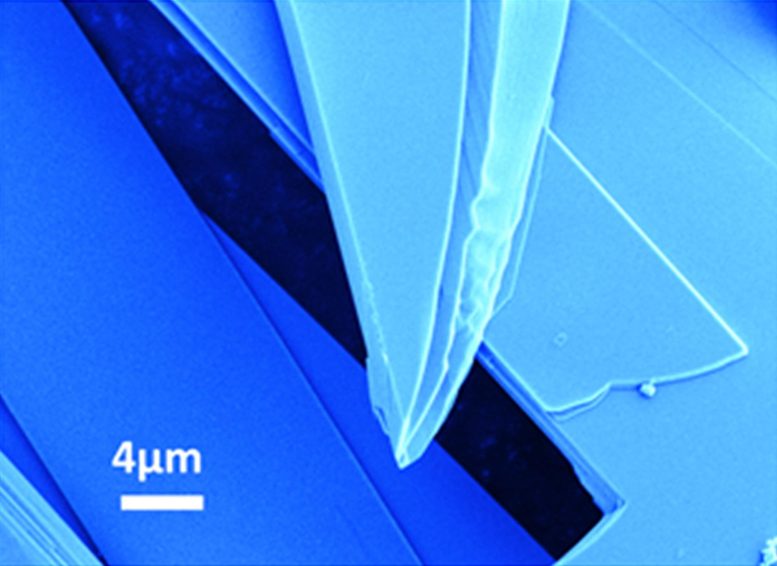
Scientists have introduced “molybdenene,” a unique 2D metallic material. Exhibiting impressive heat resistance and potential in enhancing battery performance, molybdenene also shows promise in atomic microscopy and spectroscopy applications. Credit & Copyright: Sahu, T.K., Kumar, N., Chahal, S. et al., Nat. Nanotechnol. (2023), https://doi.org/10.1038/s41565-023-01484-2 (CC BY 4.0)
Researchers have developed a new 2D material named “molybdenene.” Composed of a single atomic layer of molybdenum atoms, this material stands out due to its metallic nature.
Two-dimensional materials like graphene show fascinating properties such as superconductivity, extraordinary strength, and exotic quantum phenomena. Scientists at Forschungszentrum Jülich, together with partners from the Indian Institute of Technology in Patna and the Australian University of Newcastle, have now created a special material of this kind that exhibits a metallic character. It consists of just one atomic layer of molybdenum atoms and is also referred to as “molybdenene.”
Comparison With Graphene
The scientists succeeded in producing a thin sheet of the metal molybdenum, which is just one atomic layer thick. The new material is thus similarly thin as graphene, probably the best-known 2D material. The latter consists of carbon and was first isolated in 2004. The discovery aroused great attention because graphene conducts electricity and heat far better than copper and is a hundred times more stable than steel. At the same time, it is exceptionally light and flexible. Due to its special 2D structure, graphene also exhibits some unusual electromagnetic effects that could enable groundbreaking innovations in the field of quantum technology.
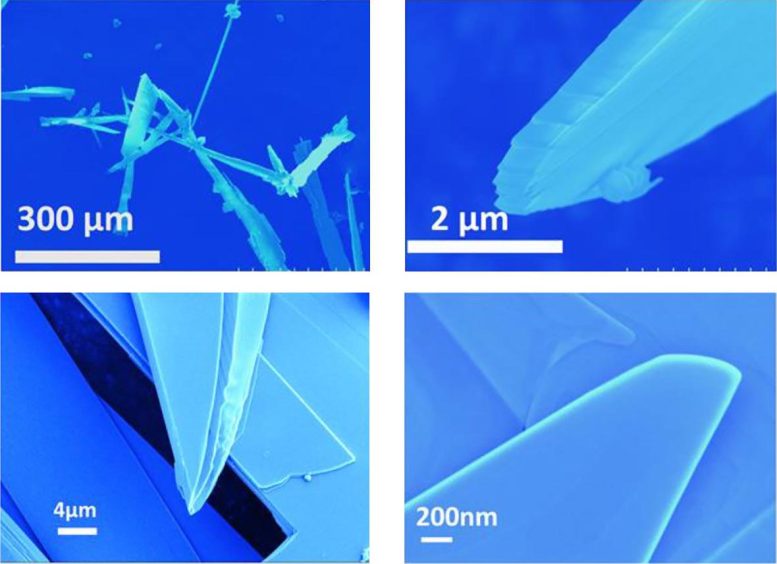
Electron microscope images of the hair-shaped structures, also known as “whiskers,” which contain the thin molybdenene layers. Credit & Copyright: Sahu, T.K., Kumar, N., Chahal, S. et al., Nat. Nanotechnol. (2023), https://doi.org/10.1038/s41565-023-01484-2 (CC BY 4.0)
The Uniqueness of Molybdenene
In recent years, other 2D materials such as phosphorene or germanene have been introduced. Like molybdenene, they exhibit some impressive properties, while the latter still differs from other 2D materials in some aspects. “Many 2D materials are sensitive to heat, but molybdenene is not. Moreover, this is the first metallic 2D material where free-standing layers could be prepared” explains Prof. Ilia Valov from the Peter Grünberg Institute (PGI-7) at Forschungszentrum Jülich.
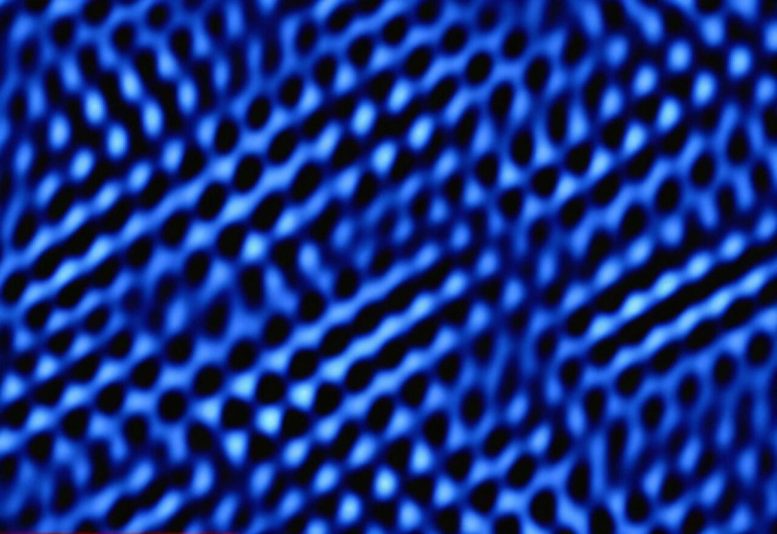
High-resolution electron microscope image of the molybdenene surface. Credit & Copyright: Sahu, T.K., Kumar, N., Chahal, S. et al., Nat. Nanotechnol. (2023), https://doi.org/10.1038/s41565-023-01484-2 (CC BY 4.0)
Creation and Potential Applications
The researchers created the new 2D material using a microwave, in which they heated a mixture of molybdenum sulfide (MoS2) and graphene to incandescence at a temperature of around 3000 degrees Celsius. In a reaction driven by the microwave electric field, finely branched hair structures, also known as “whiskers,” were formed in which the tapered molybdenum layers can be found.
In the first tests, the scientists could already observe a variety of useful properties. “Molybdenene is mechanically extremely stable. It could be used, for example, as a coating for electrodes to make batteries even more powerful and robust,” explains Ilia Valov. The researchers expect that the material has further exotic electronic properties, similar to graphene, because of its special 2D structure. Due to its metallic character, it also has freely moving electrons. These accumulate on the two side sides of the molybdenene, which makes the material an interesting candidate for catalysts to accelerate chemical reactions.
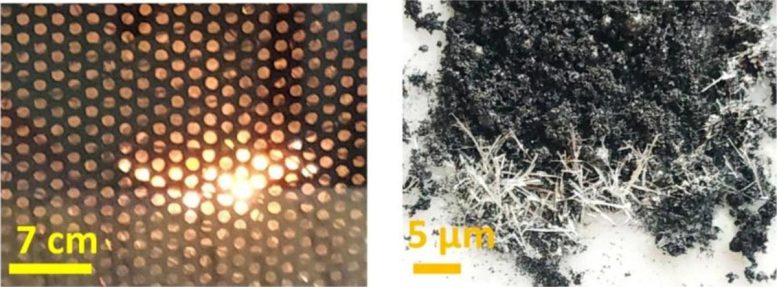
Hair-shaped structures of molybdenene (right) are formed in the microwave (left). Credit & Copyright: Sahu, T.K., Kumar, N., Chahal, S. et al, Nat. Nanotechnol. (2023), https://doi.org/10.1038/s41565-023-01484-2 (CC BY 4.0)
Practical Implementations and Collaborations
In collaboration with the Indian Institute of Technology in Patna and the Australian University of Newcastle, the researchers have already been able to develop a practical scientific application for molybdenene. Thanks to its stability and excellent electrical and thermal conductivity, it is ideally suited as a measuring tip for atomic force microscopy (AFM) and surface-enhanced RAMAN spectroscopy (SERS). Initial sample recordings show that molybdenene offers various advantages over established tip materials and, because of its thin, flat shape, is capable of providing particularly good protection against unwanted interference signals.
Reference: “Microwave synthesis of molybdenene from MoS2” by Tumesh Kumar Sahu, Nishant Kumar, Sumit Chahal, Rajkumar Jana, Sumana Paul, Moumita Mukherjee, Amir H. Tavabi, Ayan Datta, Rafal E. Dunin-Borkowski, Ilia Valov, Alpana Nayak and Prashant Kumar, 4 September 2023, Nature Nanotechnology.
DOI: 10.1038/s41565-023-01484-2




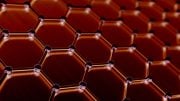



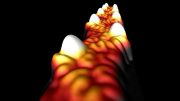
The authors are from India with whom the others have collaborated. The paper is not from Germany. If you don’t like the fact then turn this news down.
@Sandeep: what are you complaining about? I read this; then seeing your comment re-read it it: And I do not see any attempt in this article to ignore, defer, nor diguise it origins in Indian research. What are you bitching about?
It appears the article is posted to a scientific journal with funding from a German institution, with participation from both German and Australian researchers. It was not clear from the abstract or article where the research was performed, but i can’t say i typically pay much attention. I’m used to seeing Chinese names with this kind of research and it could be at any University, but frequently it is in China a. In this case, it appears research facilities were provided in India, even if the article was posted (due to separate funding) by the German side.
The first comment posted accidentally and i don’t see an edit–in any event, congratulations to the Indians for this interesting science!